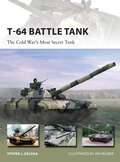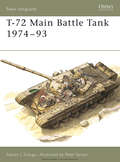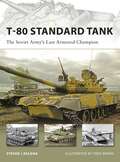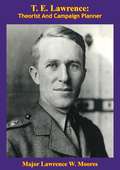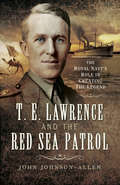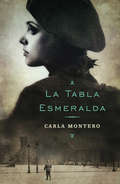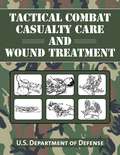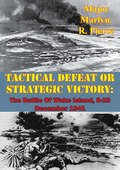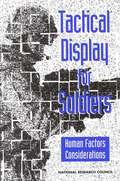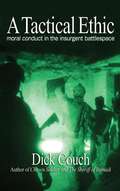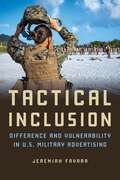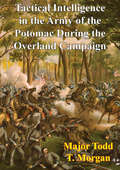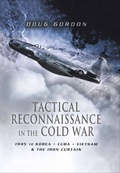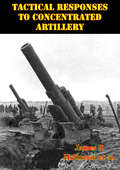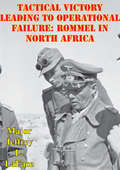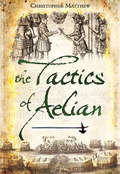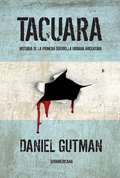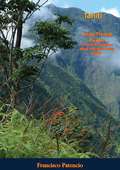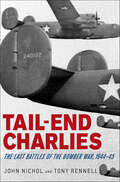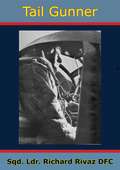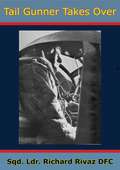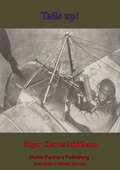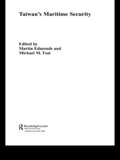- Table View
- List View
T-64 Battle Tank
by Steven J. Zaloga Ian PalmerThe T-64 tank was the most revolutionary design of the whole Cold War, designed to provide the firepower and armor protection of a heavy tank in a medium-weight design. It pioneered a host of sophisticated new technologies including laminate armor, stereoscopic tank rangefinders, opposed-piston engines, smooth-bore tank guns with discarding sabot ammunition, and gun-fired guided projectiles. These impressive features meant that the Russians were loath to part with the secrets of the design, and the T-64 was the only Soviet tank type of the Cold War that was never exported. Written by an armor expert, this detailed technical history sheds light on the secrets behind the Cold War's most controversial tank, revealing how its highly advanced technologies proved to be both a blessing and a curse.
T-72 Main Battle Tank 1974-93
by Steven Zaloga Peter SarsonThe Russian T-72 Ural tank is the most widely-deployed main battle tank of the current generation. Used by the armies of the former Warsaw pact and Soviet Union, it has also been exported in large numbers to many of the states in the Middle East. This book reveals the previously secret history behind the tank. Steven J Zaloga examines the conditions under which the T-72 was designed and produced. Technical aspects of the weapon are also discussed, including its EDZ reactive armour which, when it first appeared in December 1984, gave NATO a nasty shock.
T-80 Standard Tank: The Soviet Army's Last Armored Champion
by Johnny Shumate Steven ZalogaThe Soviet T-80 Standard Tank was the last tank fielded before the Soviet collapse, and the most controversial. Like the US M1 Abrams tank, the T-80 used a turbine power plant rather than a conventional diesel. Although the design was blessed with some of the most sophisticated armament, fire controls, and multi-layer armor ever fielded on a Soviet tank, its power plant remained a source of considerable trouble through its career. It saw very little service in the Chechen War, though T-80 tanks were used in some of the regional conflicts in the former Soviet Union in the 1990s. Although the collapse of the Soviet Union might seem the end of the story, the T-80 lived on in Ukraine where one of its tank plants was based. A diesel powered version of the T-80 was developed, the T-84, which was successfully exported, including a major sale to Pakistan to counterbalance the Indian Army's Russian T-90 tanks. Steven J Zaloga charts the little-known history of the T-80, covering the initial construction, through the development to the subsequent variants, the T-84 and Russia's enigmatic "Black Eagle Tank." Accompanying detailed cut-away artwork illustrates the unusual design features that made the T-80 so controversial. From the Trade Paperback edition.
T. E. Lawrence: Theorist And Campaign Planner [Illustrated Edition]
by Major Lawrence W MooresIncludes World War One In The Desert Illustration Pack- 115 photos/illustrations and 19 maps spanning the Desert campaigns 1914-1918.This monograph analyzes T.E. Lawrence as a military theorist and campaign planner. It investigates whether Lawrence's development of his own theory of war assisted him in planning the Arab campaign during World War I. The monograph focuses in four areas. The first section discusses the historical background of Lawrence and the Arab revolt. This section establishes the basis for Lawrence's understanding of war and of the theater of operations. In addition, it identifies the aims of the Arab revolt and why Arab actions were important to the Allied cause. The second section focuses on Lawrence's theory of war. This section explains his theory and how he developed it. The third section deals with how Lawrence's theory addressed the Arab's ends (desired end state for the war), means (use of the resources available), and ways (the method for employing the means to attain the ends). In a fourth and concluding section. The monograph proposes that T. E. Lawrence's development of a theory of war did assist him in planning the Arab campaign during World War I. Lawrence's theory of war accomplished two functions. First. it clarified the past, what had happened in the Arab revolt to that point. Secondly, it helped Lawrence anticipate the future. A future that came to fruition because of Lawrence's ability to transcend his role as a theorist. Using his theory as a basis, Lawrence carried his rational approach to war into the development of an operational concept, the "war of detachment" and a fighting doctrine to fulfill it. With these means in hand, Lawrence devised a way to employ them. Logically, the way Lawrence devised was a campaign plan designed in accordance with his theory.
T.E. Lawrence and the Red Sea Patrol: The Royal Navy's Role in Creating the Legend
by John Johnson AllenAlthough many books have been written about T E Lawrence and the Arab Revolt, none before has fully explored the pivotal role of the Royal Navy in the Red Sea at the time. This is the first book to be written about the Navy's role in the success of the Arab Revolt in the creation of the legendary figure of Lawrence of Arabia. Following extensive and detailed research into the activities of the ships of the Red Sea Patrol by the author, a maritime historian and former Merchant Navy officer, it has become evident that, without the work of those ships, the Arab revolt would have failed and T E Lawrence would have remained an obscure officer in the military bureaucracy of Cairo.Lawrence was very aware of the importance and relevance of the Royal Navy in their operations in the Red Sea and commented on it on many occasions, notably in 1918, saying 'The naval side of the operations, when the time comes to tell of it, will provide a most interesting case of the value of command of the sea..'. Until now, nobody has investigated this angle in any detail. By doing this so comprehensively, this book gives a fresh dimension to the Lawrence of Arabia legend.
La tabla esmeralda
by Carla MonteroDos historias de amor separadas en el tiempo pero unidas por el misterio de un cuadro desaparecido. Un peligroso juego de amenazas e intereses ocultos que cambiará la vida de los protagonistas para siempre. Madrid, en la actualidad: hasta que El Astrólogo se cruzó en su camino, Ana, una joven historiadora del arte del Museo del Prado, llevaba una vida tranquila junto a Konrad, un rico empresario y coleccionista de arte alemán. Pero de repente llega a sus manos una carta escrita durante la Segunda Guerra Mundial que los pone sobre la pista del misterioso cuadro atribuido a Giorgione, el enigmático pintor del Renacimiento. Alentado por el enorme valor de El Astrólogo, Konrad convence a Ana para embarcarse en su búsqueda. La joven, consciente de todas las dificultades que se le presentan, pedirá ayuda al doctor Alain Arnoux de la Universidad de la Sorbona, especialista en localizar obras de arte expoliadas por los nazis. Pero esta decisión solo parece complicarle las cosas. París, durante la ocupación alemana: el comandante de las SS, Georg von Bergheim, militar de élite y héroe de guerra, acaba de recibir una orden: debe encontrar el paradero de un cuadro de Giorgione conocido como El Astrólogo. Hitler está convencido de que la obra esconde un gran enigma, una revelación que ha pasado de mano en mano durante siglos. La búsqueda conduce al comandante hasta la joven judía Sarah Bauer, iniciándose entre ellos una persecución trepidante que tendrá consecuencias totalmente inesperadas para ambos. La autora Julia Navarro opina...«Una gran novela ambientada en una época dramática que me ha atrapado y emocionado.»
Tactical Combat Casualty Care and Wound Treatment
by U.S. Department of DefenseMilitary surgeons must assume a leadership role in combat casualty care in circumstances that are far less than ideal. This handbook provides much of the information needed to tackle these issues and features state-of-the-art principles and practices of forward trauma surgery as used by military physicians in far flung locations around the globe. In this volume you’ll learn such integral skills as: * Tactical field care * Field dressing * Applying pressure dressing * Treating burns * Treating inhalation injuries * And more! Tactical Combat Casualty Care and Wound Treatment is the most trusted and up-to-date manual offered by the Department of Defense for military medical personnel in the field.
Tactical Defeat Or Strategic Victory: The Battle Of Wake Island, 8-23 December 1941
by Major Marlyn. R. PierceGiven the constrained environment the US Armed Forces operate in would it be possible or even strategically feasible to relieve a cut-off force. This study investigates this scenario by using the historical example of Wake Island.Wake Island is an insignificant strip of coral located in the central Pacific. However, it gained strategic significance during pre-war planning. From its location, Wake Island could dominate the sea-lanes through the central Pacific.After the beginning of hostilities in 1941, the Japanese attacked Wake Island by air for three days before attempting an amphibious assault on 11 December. Miraculously, the defenders repulsed the Japanese. The only time during the Pacific War that an invasion attempt was defeated. Humiliated by the defeat, the Japanese returned on 23 December with a larger force. The defenders, again, put up a stubborn defense but eventually were overwhelmed.After the defenders defeated the Japanese on 11 December, the Navy's senior leaders were forced to decide on the fate of the men on Wake Island. In the final analysis it was determined that the strategic loss of any of three aircraft carriers operating in the Pacific outweighed the tactical gain of relieving the beleaguered island.
Tactical Display for Soldiers: Human Factors Considerations
by Panel on Human Factors in the Design of Tactical Display Systems for the Individual SoldierThis book examines the human factors issues associated with the development, testing, and implementation of helmet-mounted display technology in the 21st Century Land Warrior System.Because the framework of analysis is soldier performance with the system in the full range of environments and missions, the book discusses both the military context and the characteristics of the infantry soldiers who will use the system. The major issues covered include the positive and negative effects of such a display on the local and global situation awareness of the individual soldier, an analysis of the visual and psychomotor factors associated with each design feature, design considerations for auditory displays, and physical sources of stress and the implications of the display for affecting the soldier's workload. The book proposes an innovative approach to research and testing based on a three-stage strategy that begins in the laboratory, moves to controlled field studies, and culminates in operational testing.
A Tactical Ethic
by Dick CouchFollowing the success of his recent book on Navy SEALs in Iraq, The Sheriff of Ramadi, bestselling author and combat veteran Dick Couch now examines the importance of battlefield ethics in effectively combating terrorists without losing the battle for the hearts of the local population. A former SEAL who led one of the only successful POW rescue operations in Vietnam, Couch warns that the mistakes made in Vietnam forty years ago are being repeated in Iraq and Afghanistan, and that the stakes are even higher now. His book takes a critical look at the battlefield conduct of U.S. ground-combat units fighting insurgents in Iraq and Afghanistan. Since the prize of the fight on the modern battlefield is the people, he warns every death has a consequence. Every killing has both strategic and moral significance for U.S. warriors. From his unique and qualified perspective, Couch examines the sources and issues that can lead to wrong conduct on the battlefield, and explains how it comes about and what can be done to correct it. He considers the roles of command intent and the official rules of engagement, but his primary focus is on ethical conduct at the squad and platoon level. Tactical ethics, according to the author s definition, is the moral and ethical armor that should accompany every American warrior into battle, and these standards apply to the engaged unit as well as to the individual. A harsh critic of immoral combat tactics, Couch offers realistic measures to correct these potentially devastating errors. He argues that as a nation, we must do all we can to protect our soldiers humanity, for their sake, so they can return from service with honor, and for our sake as a people and for our standing in the world.
Tactical Force (Declan’s Defenders #5)
by Elle JamesTheir search for an assassin makes her the next target.Two attacks on DC staffer Anne Bellamy’s life are just the beginning of a terrorist threat from a group that aims to assassinate the US president. It’s all-out war for former elite Force Recon marine Jack Snow, who is tasked with keeping Anne alive. As his mission takes him undercover into Washington’s power circles, can he protect his country and the woman who’s become way more than just an asset to him?
Tactical Inclusion: Difference and Vulnerability in U.S. Military Advertising (Feminist Media Studies)
by Jeremiah FavaraThe revolution in military recruitment advertising to people of color and women played an essential role in making the US military one of the most diverse institutions in the United States. Starting at the dawn of the all-volunteer era, Jeremiah Favara illuminates the challenges at the heart of military inclusion by analyzing recruitment ads published in three commercial magazines: Sports Illustrated, Cosmopolitan, and Ebony. Favara draws on Black feminism, critical race theory, and queer of color critique to reveal how the military and advertisers affected change by deploying a set of strategies and practices called tactical inclusion. As Favara shows, tactical inclusion used representations of servicemembers in the new military to connect with people susceptible to recruiting efforts and rendered these new audiences vulnerable to, valuable to, and subject to state violence. Compelling and eye-opening, Tactical Inclusion combines original analysis with personal experience to chart advertising’s role in building the all-volunteer military.
Tactical Intelligence In The Army Of The Potomac During The Overland Campaign
by Major Todd T. MorganThis study examines how Lieutenant General Ulysses S. Grant and the Army of the Potomac used tactical intelligence during the Overland Campaign. Although Grant did not achieve his operational objective to defeat General Robert E. Lee in the field, tactical intelligence allowed him to continue the operational maneuver of the Army of the Potomac, which later contributed to the eventual defeat of Lee in April of 1865. The examination of tactical intelligence in the Army of the Potomac covers the period of 4 May to 12 June 1864. It encompasses campaign planning and preparation, as well as the battles of the Wilderness, Spotsylvania Court House, North Anna River, and Cold Harbor. The study combines a general contextual overview of the campaign and battles with a focused discussion and analysis of tactical intelligence collection and use. The study also includes background discussion of influences that contributed to the lack of intelligence functions in the War Department and the Union Army, the intelligence organizations that emerged in the Army of the Potomac, and description of the primary forms and methods of tactical intelligence collection used during the campaign.
Tactical Reconnaissance in the Cold War: 1945 to Korea, Cuba, Vietnam & the Iron Curtain (Pen And Sword Large Format Aviation Bks.)
by Doug GordonThe little-known stories of the United States Air Force pilots who flew alone and unarmed into enemy territory in a world under threat of nuclear war. Tactical Reconnaissance in the Cold War describes how the United States Air Force tactical reconnaissance units operated from the end of World War II until the 1970s. This was an immensely active period that also included major conflicts in Korea and Vietnam. It was also a period of rapid technological development in aircraft and photographic techniques. This highly-illustrated book includes chapters on: the post-war period in Europe and the East; the Korean Conflict and the role of the 67th TRW from 1950 to 1954; the role of the highly secret RF-86 missions over Red China and the Soviet Far East in the early to mid &’50s; the RB-57A missions out of Bitburg and Yokota flying clandestinely over the Soviet Union and the RF-100A missions that were flown over the Soviet Union from Turkey, Rhine-Main and Yokota; United States Air Forces in Europe; the Cuban Missile Crisis and the role of the RF-101 Voodoos and RB-66s.
Tactical Responses To Concentrated Artillery
by James R. Holbrook Michael E. DunnThe focus of this study is on how the armies of different nations countered the threat of massive concentrated artillery and/or other types of preparatory fires. Not all were successful, and the reasons for the success or failure of each army provides the contemporary military commander an opportunity to learn from his "predecessors" and benefit from their hard-learned lessons.
Tactical Victory Leading To Operational Failure: Rommel In North Africa
by Major Jeffrey L. LaFaceSince the end of the Cold War, the worldview is that the US is presently the only superpower. The expectation, within the Department of Defense and the world's other military institutions, is that this status will exist for the next twenty years or until the year 2020. Even as the world's only superpower, the U. military has adopted a formal approach to joint and coalition warfare as the methodology to fight future military conflicts. This is for two reasons. The first reason is to gain world and national political consensus and legitimacy for any operation requiring the use of US military forces. The second reason is even the military resources of the US are limited and we must conduct military operations as part of a joint coalition force in order to reach our and the coalition's political endstate.This monograph asks the question: Can tactical victories guarantee the accomplishment of the coalition's operational aim? This monograph will use the example of the Afrika Korps in North Africa to answer this question. The purpose of the monograph is to show the outcome when a more militarily capable member of a coalition dictates the conduct of military operations. This consideration is relevant to the US Army due to our superpower status and our military capabilities relative to the rest of the world's military organizations. The monograph will show that Rommel's reliance on the tactical level of war and his lack of an operational understanding of what he was attempting to accomplish lead to their defeat in North Africa. Rommel's conducted tactical operations because he was not trained for or capable of conducting operational art. Because of this, he failed to support the strategic and operational aims of the political and military leadership. He lacked the cognitive creativity and therefore, the tension to support his government. Rommel's opportunism led to many victories on the battlefield but ultimately had an adverse effect on the Axis war effort.
The Tactics of Aelian
by Christopher MatthewAelian's work on tactics is a hugely significant piece of ancient military literature, yet the last new edition in English was published in 1814. Although writing (in his native Greek) in the second century AD, Aelian drew heavily on earlier works, such as Asclepiodotus, to put together a comprehensive manual of warfare in the Hellenistic period (late 3rd to early 1st centuries BC). His Tactica thus examines all facets of warfare in the period of Alexander the Great's successors, including the arms and armor of cavalry and infantry, formations, commands and signals. Aelian also provides a discussion of the Roman army of the period. As well as being an invaluable source for modern historians studying the Hellenistic period, the book was very influential on military theory long after Aelian's death. Arrian's work on tactics may merely be a revision of Aelian's; the Byzantine Emperor Leo VI used excerpts in his own treatise and an Arabic translation made around 1350 was used to train Muslim armies. Most significantly it became one of the primary training aids for the pike and musket armies of the 16 and 17th century Europe. A substantial edition published in London in 1616 contained a full direct translation as well as comprehensive notes and a treatise on how to apply Aelian's work to the training of English pike formations in the Macedonian manner. It was well used to train the foot regiments that fought the English Civil War. This unique longevity makes it of interest to anyone interested in warfare from the Hellenistic period right up to the English Civil War. Christopher Matthew's new edition is based on the 1616 edition but written in modern English with new renditions of all its accompanying figures. It has the original 1616 notes as well as comprehensive new notes and cross references to the other ancient manuals (such as Arrian and Leo) that drew upon it. It is without a doubt the most up to date version available in any language of this significant work that was influenced tactical thought for 1,500 years.
Tacuara
by Daniel GutmanEl Movimiento Nacionalista Tacuara atrajo a comienzos de los años #60 a cientos de jóvenes que vieron allí una expresión de rebeldía contra el sistema. Nacido como un grupo anticomunista, antidemocrático y antisemita, desarrolló una capacidad para la acción violenta callejera que fue envidia de la propia Juventud Peronista. Sin embargo, la incorporación masiva de miembros con distintas visiones del mundo fue lo que sumió al movimiento en un complicado proceso de transformación. Así, mientras un sector afirmó su identidad, otro produjo una enorme conmoción cuando saltó a la escena como la primera guerrilla urbana de la historia argentina, con el cinematográfico asalto al Policlínico Bancario. Tacuara fue la escuela en la que convivieron y se formaron jóvenes que en los #70 serían líderes en las organizaciones guerrilleras, integrantes de los grupos de la derecha peronista, matones de los sindicatos y hasta agentes de inteligencia vinculados a la represión estatal. Esta segunda edición de Tacuara revisa la investigación que reveló el complejo proceso que llevó a aquellos compañeros de militancia juvenil a enfrentarse a la muerte. Es esencial no sólo para conocer la Argentina de los #60, sino también para entender la que llegaría poco tiempo después con el baño de sangre de los #70.
Taffy of Torpedo Junction
by Nell Wise WechterBack in print A longtime favorite of several generations of Tar Heels, Taffy of Torpedo Junction is the thrilling adventure story of thirteen-year-old Taffy Willis, who, with the help of her pony and dog, exposes a ring of Nazi spies operating from a secluded house on Hatteras Island, North Carolina, during World War II. For readers of all ages, the book brings to life the dramatic wartime events on the Outer Banks, where German U-boats turned an area around Cape Hatteras into 'Torpedo Junction' by sinking more than sixty American vessels in just a six-month period in 1942. Taffy has been enjoyed by young and old alike since it was first published in 1957.
Tahiti, Voyage Through Paradise: The Story of a Small Boat Passage Through the Society Islands
by George Teeple EgglestonCameras in hand and Tahiti in their hearts, the Egglestons started off on a French boat from Panama. Once in Papeete they revelled in its scenery, its charming people and its surrounding waters, and there is that quality to the author's description that seems to get at the heart of the place—historically and socially—as well as to the roots of its breathtaking loveliness. (Tahiti and) Moorea, Raiatea and Tahaa, of Bora Bora and finally, 500 miles further out, of gem-like Rarotonga.-Kirkus Reviews
Tail-End Charlies: The Last Battles of the Bomber War, 1944–45
by John Nichol Tony RennellIn Tail-End Charlies, John Nichol and Tony Rennell tell the astonishing and deeply moving story of the controversial last battles in the skies of Germany through the eyes of the forgotten heroes who fought them.Night after night they stifled their fears and flew through flak and packs of enemy fighters to drop the bombs that would demolish the Third Reich. The airmen of the United States 8th Army Air Force American and British Bomber Command were among the greatest heroes of the Second World War, defying Hitler in the darkest early days of the war and taking the battle to the German homeland when no one else would.Toward the end of the conflict, too, they continued to sacrifice their lives to shatter an enemy sworn never to surrender. Blasted out of the sky in an instant or bailing out from burning aircraft to drop helplessly into hostile hands, they would die in their tens of thousands to ensure the enemy's defeat. Especially vulnerable were the "tail-end Charlies"---for the Americans, which meant two things: the gunners who flew countless missions in a plexiglass bubble at the back of the bomber, and the last bomber in the formation who ended up flying through the most hell, and for the British, the rear-gunners who flew operations in a Plexiglas bubble at the back of the bomber.
Tail Gunner [Illustrated Edition]
by Sqd. Ldr. Richard Rivaz DFCIncludes the Aerial Warfare In Europe During World War II illustrations pack with over 200 maps, plans, and photos.Originally published in 1943, this is one man's first-hand account of the part he played in RAF Bomber Command's fledgling bomber offensive between August 1940 and December 1941.Richard Rivaz flew as tail gunner to Leonard Cheshire, one of the most famous RAF pilots of World War II. His modest but vivid narrative reveals what it was like to be part of a heavy bomber crew flying first Whitleys and then Halifaxes with No.s 102 and 35 squadrons.--Print Ed.
Tail Gunner Takes Over [Illustrated Edition]
by Sqd. Ldr. Richard Rivaz DFCIncludes the Aerial Warfare In Europe During World War II illustrations pack with over 200 maps, plans, and photos.The follow-up to the successful "Tail Gunner," Rivaz' firsthand account of the part he played in RAF Bomber Command's fledgling bomber offensive between August 1940 and December 1941. After his heroic exploits as a tail gunner he moved on to flight training in Canada. This book was published just prior to his untimely death on October 13th, 1945, having survived the Second World War.
Tails Up!
by Colonel John Buchan Edgar Charles MiddletonThe battle in the air above the trenches has held an enduring fascination for generations; the plane itself was only a new development when the First World War started and the pioneers sought to gain any advantage in the skies over their opponents. Edgar Middleton wrote copiously on the subject as well as active air service was involved with the Aeronautical Institute of Great Britain, in this book he records in sketches and anecdotes the reality of the air-war.The author was a well-respected and long-serving war correspondent of the air war for such papers and magazines as Cassell’s Magazine, Daily Chronicle, Daily Express, Evening News, Flying, New York Sun, and The Star.Author — Middleton, Edgar Charles, 1894-1939.Foreword— Colonel Buchan, John, 1875-1940.Text taken, whole and complete, from the edition published in London: Simpkin, Marshall, Hamilton, Kent, 1918Original Page Count – 314 pages
Taiwan's Maritime Security
by Martin Edmonds Michael M. TsaiThe relationship between Taiwan and the People's Republic of China is regarded as a very serious potential source of conflict in East Asia, especially now that the questions of Hong Kong and Macau have been settled, and increased democratisation in Taiwan is seen as a threat by mainland China. This book, which brings together leading international scholars of maritime security and also strategic thinkers from within Taiwan itself, examines a wide range of questions concerning Taiwan's perception of the naval threat from mainland China, and how Taiwan's navy and naval strategic thinking is responding, including discussions of the strength of Taiwan's naval forces, mainland China's claims and ambitions in the South China Sea, and the controversial question of Theatre Missile Defence.
